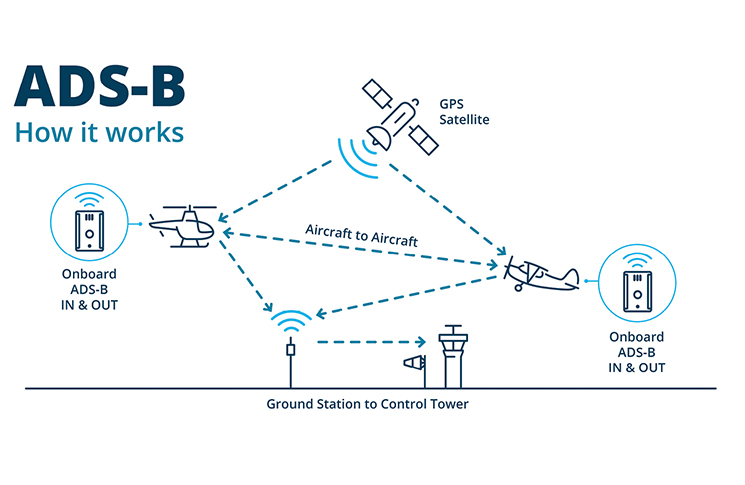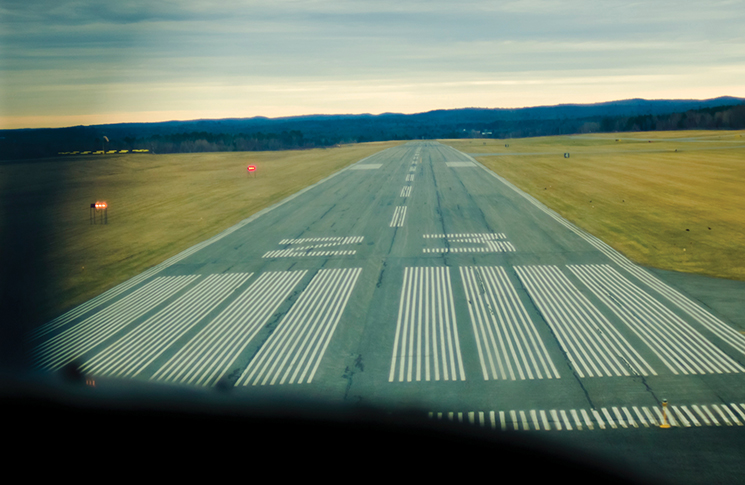Automatic dependent surveillance-broadcast (ADS-B) is a highly impressive technology – your aircraft should have it, no question. But it is not miraculous and does not remove your obligation to maintain an effective visual scan of what is happening outside.

There’s a dangerous myth about ADS-B that we need to discuss: ‘This system will eliminate the risk of midair collisions.’ If only. Perhaps this could be true if the skies only contained aircraft with the most capable ADS-B systems and we also eliminated human error and equipment failure from aviation.
Another misconception is that when you have ADS-B, air traffic controllers can always ‘see’ you and keep you safe from other aircraft. It’s a lot more nuanced than that.
In parallel with this, there are many benefits offered by the ADS-B system. Recognising these benefits, the Australian Government is offering a rebate of up to $5,000 per aircraft to cover half the cost of buying and installing a unit.
An ADS-B unit serves a similar function to a transponder but there’s a key difference. Mode A, C and S transponders transmit when they are ‘interrogated’ by radar. However, ADS-B equipment transmits information about an aircraft automatically.
The mode A transponder responds to interrogations with a code, such as 1200 or the code assigned to you by ATC and entered into the transponder by the pilot, while mode C responds with the aircraft’s pressure altitude. Australia requires transponders with both Mode A and C capability (i.e. a Mode A/C transponder). Mode S offers more advanced communication capabilities than mode A/C transponders, by transmitting an aircraft’s unique identifier (24-bit code) and other information like speed and heading. A more advanced Mode S transponder called ‘mode S extended squitter’ (ES) (what a fantastic term!) can transmit additional information, including ADS-B. A mode S ES transponder connected to a suitable GPS position source is the foundation for transmitting ADS-B. A lower cost, less capable alternative is an electronic conspicuity (EC) device, a non-transponder-based ADS-B system.
Seen in all the right places – mostly: The ADS-B ecosystem
ADS-B signals transmitted from an aircraft can be received within line of sight by dedicated ground-based receivers or airborne receivers. However, if you are flying at 1,000 feet AGL up a valley in Class G, you are unlikely to be within line of sight of a ground-based ADS-B receiver. So, look out.
Airservices Australia operates a network of ground stations that receive transponder-quality ADS-B signals. That data is fed into their surveillance system, to appear as a symbol on an air traffic controller’s display. Importantly, ADS-B can be used by ATC when the equipped aircraft is outside radar coverage, but within the coverage of the ADS-B network. But is it important to be mindful that their surveillance system cannot display information from an EC device.
The ins and outs
Some definitions before we go on:
- ADS-B Out is the transmission of ADS-B information from an aircraft to other aircraft or to the ground.
- ADS-B In is the on-board reception of ADS-B Out transmissions to allow a cockpit display of nearby aircraft to the pilot of the ADS-B In equipped aircraft.
Eyes peeled: see and be seen
You still need to look out the window. ‘Eyes outside’ is in no way replaced by ADS-B traffic information, but visual scanning can be more effective in conjunction with screen-displayed traffic. Knowing where to look improves the chances of seeing the other aircraft. However, an information-rich screen can easily be distracting – pilots should be mindful of this and minimise ‘heads-down’ time.
Murray Gerraty is a Grade 1 GA instructor and an RA senior instructor with Part 135 aircraft types in his logbook. ‘Visual scanning, good radio work and predictable flight paths remain the solid foundations of collision avoidance,’ he says. ‘A transponder with ADS-B Out reduces the workload of flight services in congested airspace. Because ADS-B gives controllers your registration and lots of flight data, it helps them provide collision avoidance information more easily.’
Relying heavily on ADS-B for collision avoidance can have terrible consequences. In 2019 in Canada, a converging DHC-2 Beaver and DHC-3 Otter, looking out for each other, collided. The Beaver had a traffic display system that could provide aural alerts, but the Otter’s ADS-B was faulty and not transmitting pressure altitude data. Five people died and 9 were seriously injured.
‘You definitely need to keep your head outside’, stresses Gerraty. ADS-B won’t show you an aircraft that doesn’t have an ADS-B transmitter.
CASA’s Advisory Circular AC 91-23 v1.1 (ADS-B for enhancing situational awareness) has good advice. ‘Do not rely solely on the depiction of traffic on the device screen for traffic avoidance action; it is critical that pilots sight other aircraft and maintain visual separation,’ it says.
Michael Monck, Chair of Recreational Aviation Australia (RAAus), says, ‘Most RA pilots appreciate that if you can be seen, that’s a good thing. But if you can see, that’s even better. In other words, ADS-B Out is good, ADS-B In and Out is better.’
But Monck highlights an important caveat. ‘We have a number of pilots who fly aircraft not really capable of supporting advanced avionics,’ he says. ‘They might operate in fairly unpopulated spaces, outside of controlled airspace, away from towns, flying across the countryside. For the most part, these aircraft are flying quite low – 500 to 1,500 feet – and will often be out of range of an ADS-B receiver.’
Show me the money: equipment choices
ADS-B equipment is not mandatory for most VFR aircraft in Australia. However, transponder requirements apply for operations in Class A, B, C or E airspace, or above 10,000 feet in Class G airspace.
The answer to the question of what ADS-B equipment GA and RA owners and operators should buy is not the same for everyone. Good advice might be to buy what you can afford. You will be most visible, and see more traffic, if you have a transponder-based system with both ADS-B Out and ADS-B In functionality. If you can’t afford such an upgrade, the minimum is probably an ADS-B EC device connected to a tablet EFB app.
Gerraty suggests that before upgrading, aircraft owners should consult with their avionics shop. ‘ADS-B equipment needs flight data input, so your existing equipment needs to talk to your new equipment,’ he says. ‘It’s often better to stick with the same brand of equipment as they are more likely to be compatible. If you have a panel upgrade planned down the track, then be careful that you don’t pay for some ADS-B equipment now that ends up being incompatible with your upgrade plan.’
TCAS, transponders and their limits
Some mode S transponders include an ADS-B system. Most panel-mounted ADS-B equipment include a mode S transponder.
IFR aircraft are required to have a transponder-based system with at least ADS-B Out functionality. Airliners typically will also have a traffic collision avoidance system (TCAS).
The TCAS (very rarely installed in GA and RA) sends interrogation signals which nearby aircraft with at least mode A/C transponders will respond to. If the TCAS detects another aircraft coming into conflict, it will first alert the pilot with a traffic advisory (TA). If the situation develops into a potential collision scenario, TCAS will generate a resolution advisory (RA), which alerts the pilot to manoeuvre as appropriate to avoid collision. If both aircraft have a TCAS, the system is smart enough to give each aircraft deconflicting RAs (for example, alert one aircraft to climb and the other to descend). A TCAS is helpful in non-controlled airspace operations. For example, an airliner flying into a non-controlled aerodrome will receive a TA or RA if a Warrior operating its transponder, with altitude enabled, becomes a collision risk.
But here’s an issue: TCAS cannot ‘see’ aircraft with an old mode A-only transponders or, of course, aircraft with their transponders switched off. Also, TCAS can only provide a TA (and not an RA) if a conflicting aircraft is not squawking altitude (even if it has a Mode A/C or S transponder).
Plug and play: EC devices
A cost-effective compromise to panel-mounted ADS-B transponders is an EC device. They use ADS-B to help make aircraft more conspicuous. These devices are cheaper than transponder-based systems but aren’t as capable. Importantly an EC device cannot be detected by ATC and does not meet transponder requirements for flight within controlled airspace.
Currently, the only available EC devices are capable of both ADS Out and ADS In. EC devices can be connected to other equipment in the cockpit. The typical example is a SkyEcho 2, connecting via wi-fi to an EFB (running OzRunways or AvPlan). This provides the pilot with a plan view of nearby ADS-B equipped aircraft on the EFB’s moving map.
Rebates and upgrades
If you already have ADS-B Out, you can use the government rebate to add ADS-B In. If you already have an EC device, you can use the rebate to upgrade to a transponder-based system with ADS-B Out functionality. The rebate scheme covers aircraft registered with CASA (VH aircraft) and delegated registration organisations like RAAus. To apply for the rebate, go to business.gov.au.
As part of its Aviation White Paper, the Australian Government says widespread use of ADS-B devices will increase aviation safety and efficiency and reduce collision risk. By late 2025, the Government will consider advice about a timetable for mandating ADS-B devices, while also extending subsidies for the purchase and installation of ADS-B equipment until 2027.
More information can be found in the aviation white paper.
[Thanks to Mark Newton for his help in preparing this article.]
Matrix diagram

CASA has published a matrix diagram to help understand the complexities of ‘who sees who’ based on transponders, TCAS, ADS-B In and Out, and EC device equipment.
Start with the left column to find the technology relevant to your aircraft. The chart will help you understand if you can be seen by aircraft with the equipment along the top row.





